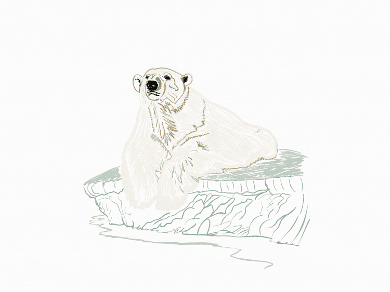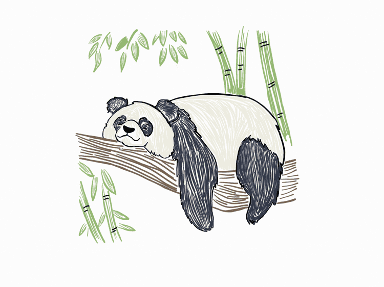Globally, among the greatest threats to wildlife and ecosystems is climate change, occurring at an alarmingly rapid pace. This is because biodiversity, closely intertwined with climate, remains the fundamental source of the planet’s well-being and human prosperity.
Can climate change threaten vital biodiversity?
We take a first look at the place where animals inhabit. The habitat is the space in which each species carries out its entire life. One change will trigger a new change, which will ultimately be reflected in the life of each animal.
How is this possible? Just think about the temperature that can affect vegetation, an important food source, access to water, and many others.
For example, in Africa, elephants (African savanna elephant, Loxodonta africana, and African forest elephant, Loxodonta cyclotis) are highly sensitive to these temperature increases, and consequently, they are exposed to new diseases. And water, which is becoming increasingly scarce due to drought and desertification, is at the same time indispensable in their lives, being necessary in large quantities.

Thus, certain ecosystems are becoming increasingly inhospitable for certain animals, forcing some of them to push their limits and transition to a different habitat in order to survive. This process leads to natural selection and the learning of how to adapt to new life situations.
The effects of these climate changes are felt both directly and indirectly on wildlife. What happens when the temperature fluctuates by 1°C? You see, the size of animals’ bodies is correlated with the habitat they inhabit. For instance, animals living in the North Pole — polar birds, polar mammals — have developed a range of anatomical, physiological, and behavioural adaptations to cope with low temperatures and high rates of heat loss. Let’s take a closer look at a few examples:
The polar bear and its relationship with shrinking ice
The protagonist of climate change is the polar bear itself, as the most pronounced activity has been recorded within the polar circle – the Arctic. This species is categorised by the International Union for Conservation of Nature (IUCN) as vulnerable. Polar bears have the ability to conquer new territories, suggesting that they might have the capacity to adapt to the ongoing changes in the Arctic. However, currently, they are highly dependent on ice, which makes them vulnerable to climate change.
Why is ice so crucial in their lives? They use ice for travel, hunting, resting, mating, and even constructing maternal dens in some areas. Polar bears are closely interconnected with their prey, which relies on ice (seals).

Being a large mammal, polar bears effectively control their body’s insulation and peripheral cooling. Heat exchange occurs in their respiratory system, and water losses are minimised; these physiological adaptations are closely linked to their activity level. Unlike other bear species that generally undergo reduced metabolic activity during winter months, polar bears remain active throughout the year. With their activity, inevitable heat losses occur.
But what has allowed them to maintain homeothermy in such an environment? Their posture is correlated with the current temperature, the polar bear’s fur has a high level of thermal conductivity (loses heat rapidly), and their well-vascularized striated muscles serve as a heat source. Notably, the hair of a polar bear can either warm or cool them using sunlight. This is due to asymmetry: based on the angle of UV light contact with the hair strands, they can produce either sufficient or partial heat. If a polar bear is photographed under UV light, it will appear black due to this effect.
The giant panda and its relationship with bamboo
Another well-known example, also an emblem of the WWF organisation, is the giant panda (Ailuropoda melanoleuca). It’s an iconic species in discussions about climate change due to its nearly exclusive diet of bamboo. It’s also categorised as a vulnerable species by the IUCN. Understanding how climate changes affect bamboo is crucial for creating conservation programs to save the giant panda.
Why is bamboo so important for the giant panda? Because it constitutes about 90% of their diet — and it also has a low reproductive rate because it’s an asexual species (all reproduction occurs within the same individual, having both female and male flowers). This indicates that bamboo cannot keep up with the giant panda’s consumption, to explore higher altitudes or latitudes. In their natural habitat, there’s noticeable fragmentation and isolation of giant panda populations, greater than observed in the past 30 years.

Where does the giant panda live? It can be found in the high-altitude temperate forests of the mountains in southwestern China. Few of us may know that the biological diversity of the giant panda’s habitat competes with tropical ecosystems, categorising it as an umbrella species that provides protection for many other species (multi coloured pheasants, golden monkeys, crested ibis, takin, etc.) living within its range.
Penguins preserve heat in groups
Penguins are another category of polar vertebrates. They inhabit the southern hemisphere, most commonly in Antarctica, but they can even be observed at the tip of Africa. There are 17 species of penguins, which are considered aquatic and poor fliers. An exception is the Galapagos penguin (Spheniscus mendiculus), found in the Ecuadorian region, the only one that lives outside the ice. The cold waters of the Humboldt and Cromwell currents support its survival in this tropical environment of the Galapagos Islands.

As survival strategies, penguins have adapted to cold temperatures in the following ways:
1. Overlapping feathers – providing protection against cold water and wind.
2. Penguins raise their body temperature by absorbing sunlight using the dark-coloured feathers on their backs.
3. They conserve heat by shivering, similar to humans; the disadvantage of shivering is energy loss.
4. Penguins are also known to huddle in groups to preserve heat.
5. The vertical position of their legs – another mechanism to prevent heat loss.
The Fennec fox hunts during the night to avoid the daily heat

Regarding species in the savannah, they contrast with those in the Arctic region by adapting to avoid overheating. A prime example is the Fennec fox (Vulpes zerda), which inhabits the Sahara Desert and North Africa. Notable adaptations include:
1. To cope with scorching daytime heat, the Fennec Fox hunts during the night.
2. Its ears resemble those of bats, providing a large cooling surface to dissipate heat.
3. Its long and thick fur provides dual protection: insulation during cold nights and shielding from the intense daytime sun.
4. The fur covers its limbs, offering protection against the hot sand during movements.
How do these changes affect the lives of animals?
Most large terrestrial and aquatic mammals cannot afford the luxury of rapid microevolution or swift changes as adaptation strategies to these climate changes. The pace of these changes is far too rapid for genetic adaptation, meaning the internal blueprint of species, to occur in larger mammals.
When we discuss these changes — which, as I mentioned above, impact everything from food sources to how animals live — we must also consider parasitic life forms such as pathogens, as some of them can become more efficient due to climate changes.
However, we can observe a few changes in behaviour, reproduction, migration, hibernation, and even post-hibernation activities. These alterations will benefit certain species while disadvantaging others, ultimately leading to the creation of new ecosystems.
She is a biologist with an active desire to discover, understand, and generally know about living organisms. Currently, she is a doctoral student at the Faculty of Veterinary Medicine in Cluj-Napoca, in the Parasitology and Parasitic Diseases department.
Carla conducts her scientific work in the Galapagos Islands, focusing on her doctoral thesis in this area. Through this project, in collaboration with her supervising professor and colleagues in the Galapagos, she aims to contribute to the conservation of an endemic species, the Galapagos sea lion.
She is also the talented illustrator behind the wonderful illustrations you enjoyed in the above article.
Article first published on InfoClima















